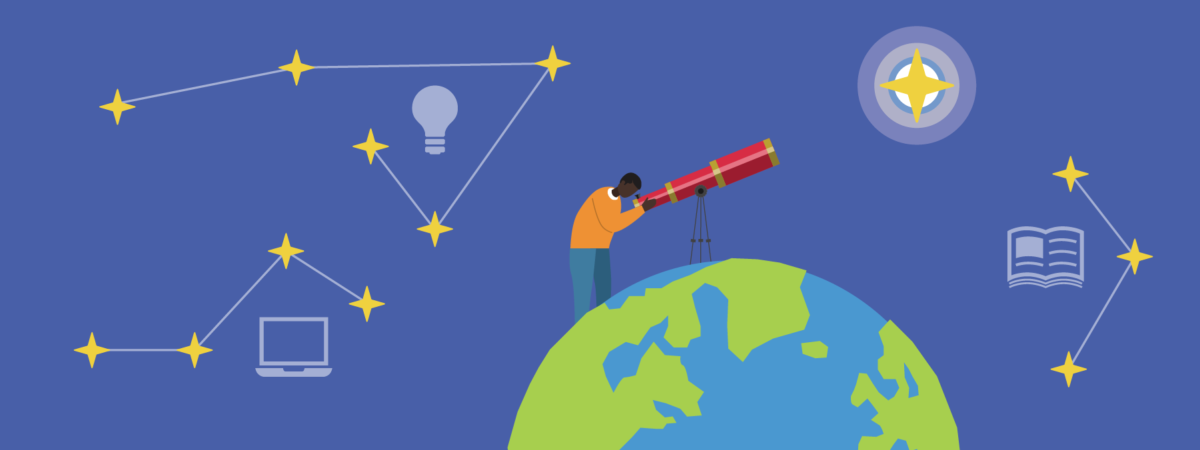
Nearly 22 years ago, two powerful leaders—Lawrence K. Grossman, former president of NBC News and PBS, and Newton N. Minow, former chairman of the Federal Communications Commission and PBS—began to push for the creation of a national center to help Americans harness the power of breakthrough technology to serve the public interest in education. This national center ultimately became what we know today as Digital Promise.
From that idea to where we are today as a global nonprofit, our mission and vision remain impressive and comprehensive, centered in the idea of helping to create a more just and equitable society. To achieve this vision requires a deep look at how our tools, solutions, research, and engagement can create more equitable, long-lasting, and comprehensive change focused on policy, practices, and mindsets.
In December, we outlined our new strategic framework and three “North Star” goals. We believe these goals align with our mandate and the vision that our original architects had for Digital Promise. This framework moves us forward and recommits us to long-term, lasting impact. We hope you join us on this journey as we imagine the future of learning.
Let’s start with, perhaps, our most important North Star goal: We want learners enabled to achieve postsecondary credentials that offer economic security, well-being, and agency. This goal aligns with what parents and young people ultimately care about: their futures. Our Lifelong Learning team has been renamed and repositioned as the Pathways and Credentials team. Focusing on the pathway from education to workforce, this team leans on their credentialing work and how those credentials are managed and shared, including the digital wallet and the student record. This work can support and enable skill development, upskilling, and reskilling through an inclusive and equitable process.
Our second goal involves creating sustained and meaningful experiences of Powerful Learning that puts learners on a path beyond high school completion. There is massive attrition in our PreK to postsecondary systems; according to research in one state, only 25 percent of learners reach two- to four-year college completion. Our work in the learning sciences, learner variability, and learning experience design—as well as our partners’ work in learning innovation, school design, and deeper learning—will help to fully define Powerful Learning as a means for curricular, pedagogical, and whole child designs that will shift this attrition narrative.
Our networks of schools, including nearly 200 school districts and more than 60,000 educators, will help us reach our goal. Additionally, the Verizon Innovative Learning Schools program will continue to demonstrate how capable devices and powerful technology can accelerate curricular and pedagogical innovations. Our understanding that there are many paths for earning a meaningful postsecondary credential—including trade schools, apprenticeships, community colleges, and universities—recognizes the value and merit of developing knowledge and skills beyond high school for lifelong success.
Lastly, we understand that to change practice at the classroom and school level, one must also focus on systems. We want learners to learn in education systems with the knowledge and tools to create the conditions for them to succeed. This third goal will focus on systems infrastructure and design. Learners who experience marginalization are often concentrated together in schools and districts—for example, the hundred largest school districts serve nearly two-fifths of learners of color, and learners of color are more likely to attend high-poverty schools. Making sure that our tools and knowledge are reaching intended audiences is a key lever. Leveraging the League of Innovative Schools and their connections to large associations of school system leaders will support the effort. Our Center for Inclusive Innovation also supports systems and partners to center the voices and resource the creative ingenuity of communities most often excluded from full participation.
To reach our goals, we are creating a measurement framework that represents our theory of action and strategic architecture. It will lean on several components, including our guiding principles, our organizational infrastructure, and our impact strategies and practices. (More information on these components can be found here.)
Ultimately, the measurement framework will allow us to track our progress toward the North Star goals and help us tell our story more powerfully, without limiting our ability to continue to innovate, collaborate, and employ bold approaches to the opportunities and challenges we face. Anchoring this work is an explicit focus on meeting the needs and aspirations of learners who are historically and systematically excluded. This approach sets out to improve outcomes for each learner, from early learning to the workforce.
As we think about the totality of our work—how our teams’ work adds to a greater whole—we believe that our North Star goals, coupled with the strategic architecture and accompanying measurement framework, will allow Digital Promise to continue to accelerate our impact.
Our journey requires expanding partnerships and communicating how we navigate the ever-evolving landscape of education while remaining steadfast in our commitment to equity. We look forward to engaging, learning, and working with our communities and partners in the field to imagine the future of learning and lifelong success.
Visit our North Star Goals page and sign up for our newsletter to stay connected with our work.